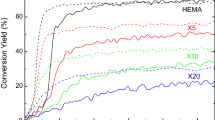Abstract
In order to obtain new organic-inorganic hybrid materials the method exploiting the phenomenon of polymer crazing was investigated. Polypropylene and polyethyleneterephtalate films were subjected to crazing to achieve high porosity. Incorporation of hydrated oxides of Mo and W in porous polymer matrix was performed by hydrolysis of alkoxides in pores using counterflow diffusion technique. It was shown that peculiarities of the hydrolysis of the initial compounds affect significantly the distribution of substances inside porous polymer matrix and the possibility of accumulation of inorganic component inside the film. Mo matter in contrast to W is easily incorporated in the polymer matrix to form a well-defined layer. These samples demonstrated high photosensitivity.
Similar content being viewed by others
References
C. Sanchez and F. Ribot, First Eur: Workshop on Hybrid Organic-Inorganic Materials (Paris, Nov. 8–10, 1993), p. 9.
L.G. Hubert-Pfalzgraf, New J. Chem. 11, 663 (1987).
M.I. Yanovskaya, I.E. Obvintseva, V.G. Kessler, B.Sh. Galyamov, S.I. Kucheiko, R.R. Shifrina, and N.Ya. Turova, J. Non-Cryst. Solids 124, 155 (1990).
N.F. Bakeev and A.L. Volynskii, Solvent Crazing of Polymers (Elsevier, Amsterdam, 1995).
N.Ya. Turova, E.P. Turevskaya, V.G. Kessler, N.I. Kozlova, and A.I. Belokon', Russ. J. Inorg. Chem. (Engl.) 37, 26 (1992).
L.I. Solov'yeva, E.P. Kovsman, and M.I. Yanovskaya, Russ. Pat. 2,017,713 (1994); CA 123, 87548 (1995).
S.I. Kucheiko, N.Ya. Turova, and V.A. Shreider, J. Gen. Chem. USSR (Engl.) 55, 2130 (1985).
E.A. Shmatok, O.V. Arzhakova, L.M. Yarysheva, A.L. Volynskii, and N.F. Bakeev, Vysokomol. Soed. (Russ.), 32A(3), 577 (1990).
S.V. Stakhanova, N.I. Nikonorova, V.D. Zanegin, G.M. Lukovkin, A.L. Volynskii, and N.F. Bakeev, Polymer Sci. USSR 34(2), 175 (1992).
V.G. Kessler, E.P. Turevskaya, N.I. Kozlova, N.Ya. Turova, I.E. Obvintseva, and M.I. Yanovskaya, in Mat. Res. Soc. Simp. Proc. (Better Ceramics Through Chemistry VI), (1994), p. 3.
W.M. Moreau, Microdevices. Physics and Fabrication Technology (Plenum Press, NY, 1988), Part I.
S. Ostrowetsky, Bull. Soc. Chim. France 5, 1003 (1964).
Author information
Authors and Affiliations
Rights and permissions
About this article
Cite this article
Borissevitch, A., Yanovskaya, M., Kessler, V. et al. Synthesis of Organic-Inorganic Hybrid Materials by Incorporation of Molybdenum and Tungsten Hydrated Oxides in Polymers. Journal of Sol-Gel Science and Technology 12, 111–115 (1998). https://doi.org/10.1023/A:1008665328863
Issue Date:
DOI: https://doi.org/10.1023/A:1008665328863




